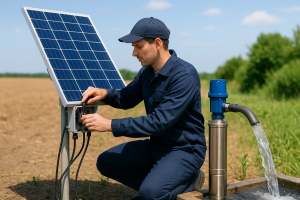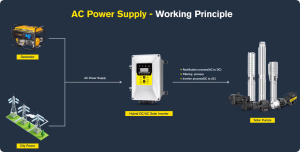In a time where sustainability is not a choice but a must, solar booster pumps are the green tech saviors. They are for those who want a green and efficient way of pumping water. These systems use solar energy to give you water when you need it. But how does a device take sunlight and turn it into water pressure? Let’s talk about how solar booster pumps work and why they’re important for our search for renewable energy solutions.
Solar booster pumps work by using solar panels to capture sunlight and convert it into electricity. This electricity is then used to power a motor that moves the pump and pushes water from one place to another. This makes solar booster pumps a great option for people who need to move water around but don’t want to rely on electricity or gas to do it.
How Solar Booster Pumps Work
Solar booster pumps work by using solar panels, also known as photovoltaic panels, to convert sunlight into electricity. This electricity powers a motor that runs the pump. It’s a simple, efficient system that uses the sun’s energy to pump water without the need for external power sources or fuel.
The Benefits of Solar Water Pumping
There are many advantages to using solar water pumps. They reduce energy costs compared to traditional pumping methods. They also use a clean, renewable energy source, which is better for the environment. Solar pumps can be installed in remote areas where grid electricity is not available or is unreliable. They can be used for a wide range of applications, from small garden irrigation to large-scale agricultural projects.
The Drawbacks of Solar Water Pumping
While there are many benefits to solar water pumping, there are also some limitations. The initial cost of setting up a solar water pump system can be higher than traditional pumps. The pump’s performance depends on the availability of sunlight. This means that the pump may not work as well on cloudy days or at night unless there is a storage solution, like a battery, in place.
How High Can Solar Pumps Lift Water?
One of the most common questions about solar pumps is, "How high can they lift water?" The answer varies, with some pumps capable of lifting water up to 1,000 feet. The main factors that determine how high a pump can lift water include the type of pump, the efficiency of the motor, and how much solar energy is available.
Pressure Pumps vs. Booster Pumps
It's important to understand the difference between pressure pumps and booster pumps. While both are designed to increase water pressure, booster pumps are specifically designed to increase the pressure of water that is already coming from a source, making them ideal for situations where the main goal is to increase water pressure rather than to draw water from a source.
Using Solar Booster Pumps
For those who are interested in using solar booster pumps for their water supply, the process involves selecting the right size pump, understanding the water demand, and making sure there is enough solar panel capacity to meet the energy needs. Installation may require professional help, especially when it comes to designing a system that works best for your specific water usage needs and the conditions in your area.
In Summary
Solar booster pumps stand at the intersection of innovation and environmental stewardship, offering a path towards more sustainable water solutions. By understanding how these pumps work, their benefits, and their limitations, solar water buyers are well-equipped to make informed decisions about integrating solar pumping systems into their water supply strategies. As we continue to embrace renewable energy technologies, solar booster pumps represent a crucial step forward in our collective journey towards a more sustainable and efficient future.



